Table of Contents
- Introduction
- Editor’s Choice
- Global Telecommunications Industry Statistics
- Global 6G Market Statistics
- 6G Spectrum Landscape Statistics
- Comparison of 6G With Previous Communication Technology Statistics
- 6G Network Use Cases Statistics
- 6G Transport Network Investment Projections Statistics
- Privacy Challenges in 6G Technology Statistics
- Recent Developments
- Conclusion
- FAQs
Introduction
6G Statistics: 6G technology, marking the sixth generation of wireless communication, is on the horizon, poised to outshine 5G networks. Its goal is to provide faster internet speeds, almost instantaneous connections, and improved device connectivity.
Its potential to support cutting-edge technologies such as augmented reality, virtual reality, and the Internet of Things makes it particularly thrilling.
The development of 6G involves collaboration among industry leaders and research institutions. Focusing on innovations like terahertz communication and intelligent networking.
As it progresses, 6G can transform various industries and reshape how we engage with the digital realm.
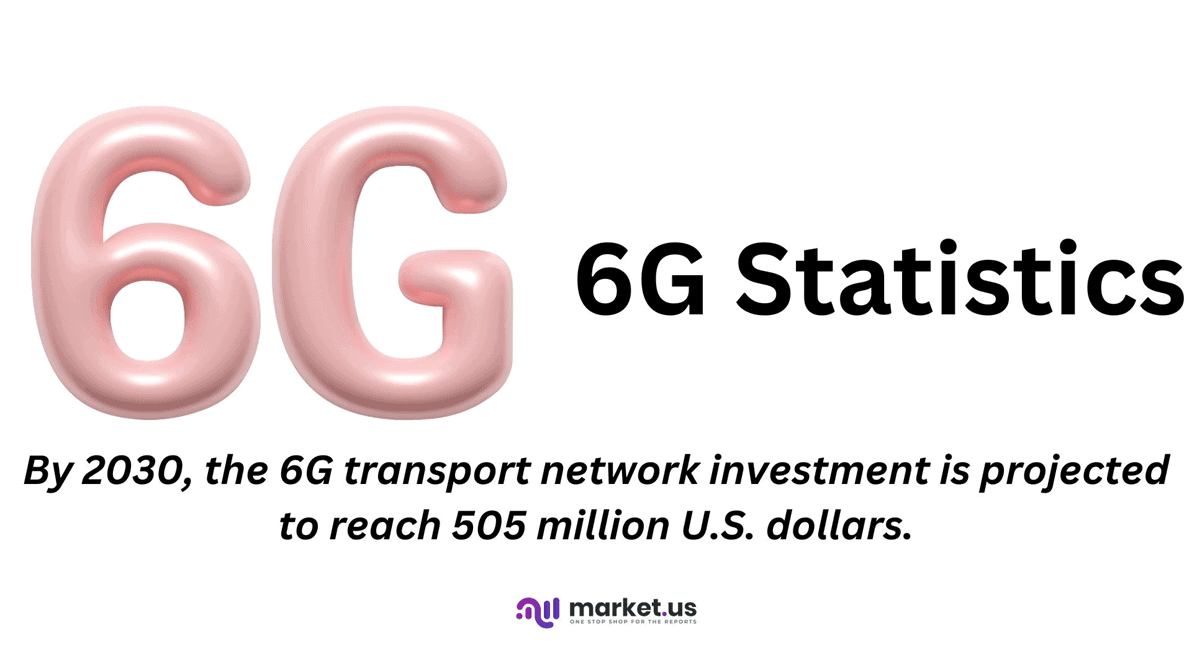
Editor’s Choice
- The Global 6G Market size is expected to be worth around USD 98.2 Billion by 2033, from USD 5.8 Billion in 2023. Growing at a CAGR of 32.7% during the forecast period from 2024 to 2033.
- In the projected landscape of 6G technology, the market size in 2028. North America is anticipated to lead the way with a substantial 6G market size of approximately 364.12 million U.S. dollars.
- The spectrum allocation for 6G includes the upper mid-band. Often called mid-band or unofficially referred to as FR3, spanning from 7 to 24 GHz.
- The range between 7 and 15 GHz is appealing due to its propagation characteristics. Which resemble those of frequencies just below 7 GHz.
- The bandwidths of up to 20 GHz are explored for 6G applications. Despite the significant technical challenges they pose.
- The data rate for 6G is projected to reach a remarkable 1 terabit per second (TBPS). A monumental leap from the 100-1000 Mbps of 5G. Indicating an unparalleled increase in data transmission speeds.
- Looking ahead to the anticipated 6G technology. It is projected to achieve an astounding peak data rate of 1000 Gbps (1 terabit per second or TBPS). An exponential leap that promises to revolutionize the mobile broadband landscape.
- By 2030, the 6G transport network investment is projected to reach 505 million U.S. dollars.
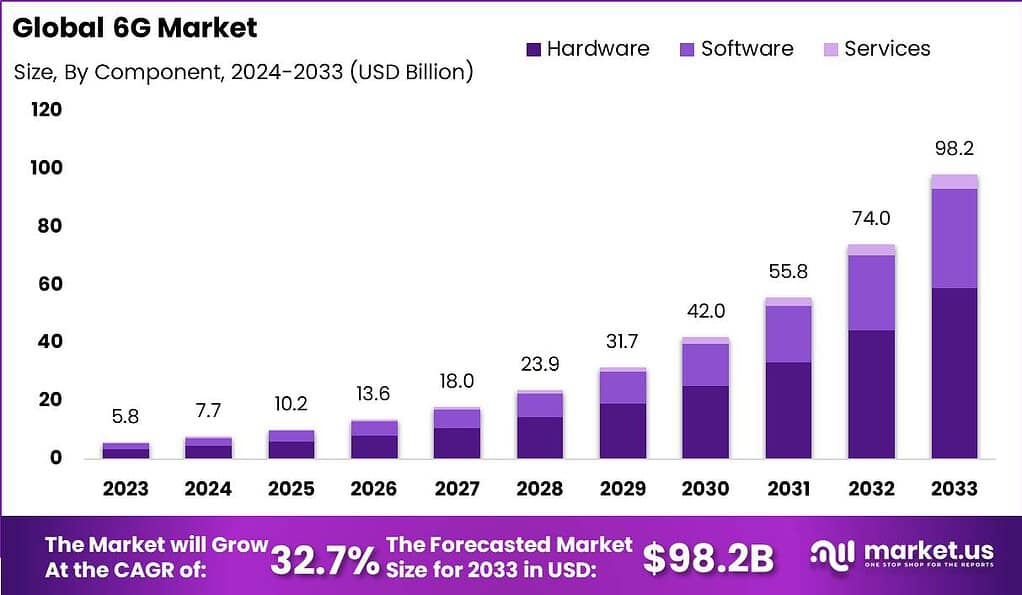
Global Telecommunications Industry Statistics
- Over the past decade, spending in the telecommunications services industry has exhibited fluctuations and trends.
- In 2010, it stood at $1,596.5 billion, and it continued to rise in the subsequent years, reaching $1,656.7 billion in 2011.
- However, the following years saw slight fluctuations, with spending at $1,641.0 billion in 2012 and $1,624.0 billion in 2013.
- Subsequently, a downward trend emerged, with spending declining to $1,541.0 billion in 2014 and further to $1,392.0 billion in 2015.
- This trend persisted until 2018 when spending leveled at $1,380.0 billion.
- In 2019, it remained relatively stable at $1,373.0 billion.
- The year 2020 saw a modest increase to $1,396.0 billion.
- In 2021, there was a notable rise to $1,458.0 billion, and projections indicate that spending will reach $1,425.0 billion in 2022. Followed by an increase to $1,480.0 billion in 2023 and $1,536.0 billion in 2024.
- These figures reflect the dynamic nature of investment in the telecommunications sector over the years.
- Furthermore, by 2024, the total revenue potential for mobile operators from Value-Added Services (VAS) is predicted to hit $120 billion. With Application-to-Person (A2P) Messaging and Machine-to-Machine (M2M) Connectivity emerging as the primary drivers of this growth.
(Source: Statista, Pareteum)
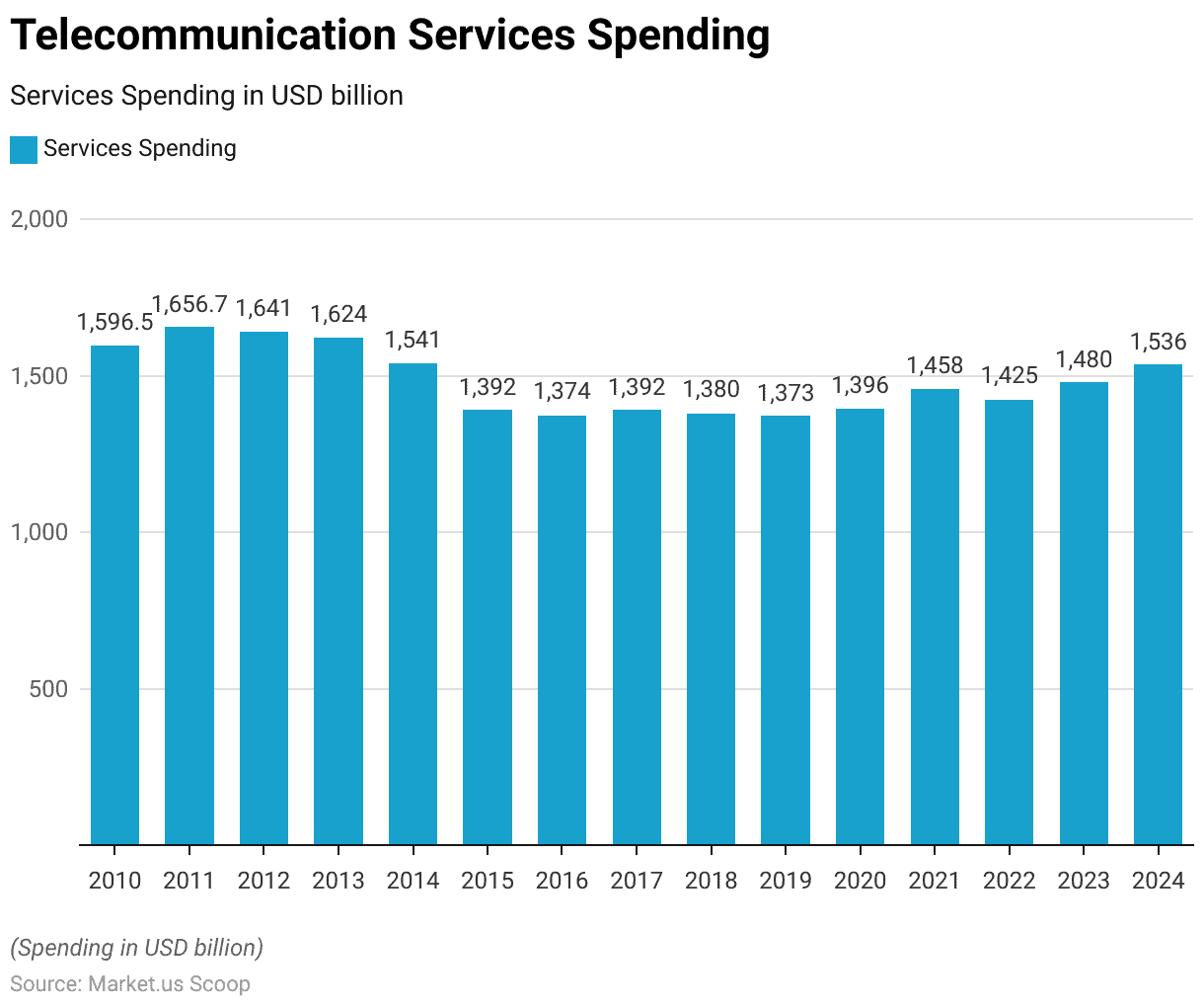
Global 6G Market Statistics
Regional Analysis of the 6G Market Statistics
- In the projected landscape of 6G technology, the market size in 2028 is expected to vary significantly across regions.
- North America is anticipated to lead the way with a substantial 6G market size of approximately 364.12 million U.S. dollars. Followed closely by China with an estimated market size of 251.14 million U.S. dollars.
- Europe is also poised to play a significant role, with a projected 6G market size of around 216.21 million U.S. dollars.
- In the Asia Pacific & Japan region, the market is expected to reach 91.66 million U.S. dollars.
- The United Kingdom is foreseen to contribute approximately 57.01 million U.S. dollars to the 6G market. While the Middle East & Africa region is expected to have a market size of about 39.83 million U.S. dollars.
- Finally, South America is projected to have a market size of roughly 26.69 million U.S. dollars.
- These estimations illustrate the regional distribution of the 6G market in 2028. Reflecting varying levels of adoption and investment in this cutting-edge technology.
(Source: Statista)
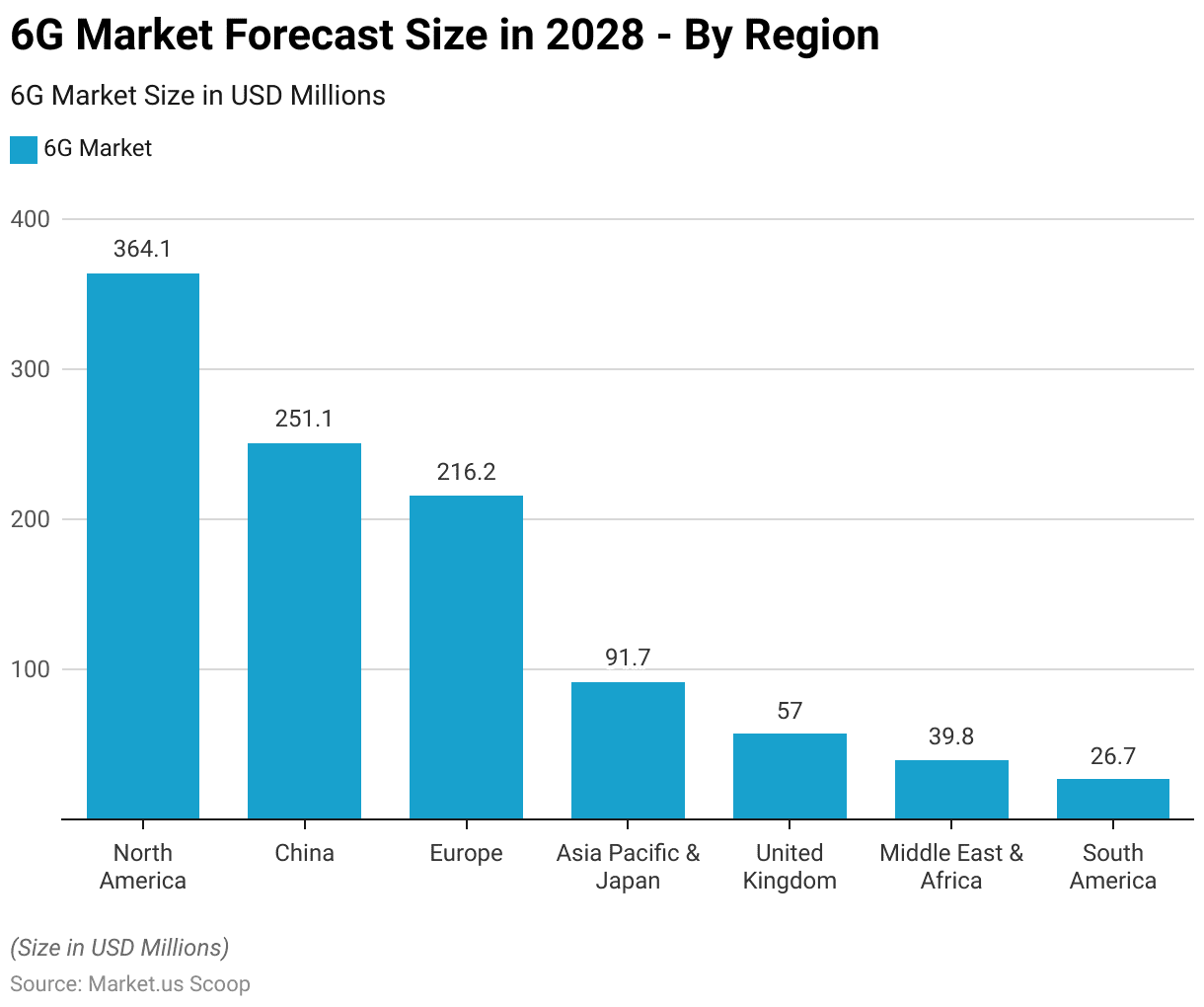
6G Spectrum Landscape Statistics
- The spectrum allocation for 6G is currently uncertain, but there are ongoing discussions about three potential frequency ranges.
- These include the upper mid-band, often called mid-band or unofficially referred to as FR3, spanning from 7 to 24 GHz.
- Additionally, there are discussions about sub-terahertz bands, covering approximately 90 GHz to 300 GHz.
- Finally, efforts are being made to maximize the available spectrum below 7 GHz through methods. Such as re-farming, allocating new bands, and enhancing spectral efficiency.
(Source: Power Electronics)
Take advantage of our unbeatable offer - buy now!

The upper mid-band (7–24 GHz)
- The range between 7 and 15 GHz is appealing due to its propagation characteristics. Which resemble those of frequencies just below 7 GHz.
- Signals in this range experience lower propagation loss compared to the FR2 spectrum. Making them better at penetrating buildings and structures, thereby enhancing indoor coverage.
- This presents an opportunity for network operators to boost capacity without the necessity of deploying a substantial number of cell sites. Which is typically required for expanding millimeter-wave (mmWave) FR2 coverage.
(Source: Power Electronics)
The sub-terahertz bands (90–300 GHz)
- Sub-terahertz frequencies, offering substantial, uninterrupted spectrum portions, are a valuable consideration for 6G.
- With bandwidths of up to 20 GHz, they should be explored for 6G applications. Despite the significant technical challenges they pose.
- There is a foreseeable need for applications demanding extremely high data speeds, exceeding 100 Gbps.
- Achieving this requires wider, uninterrupted bandwidths than those found in lower frequency bands.
- Although there are technical hurdles, these frequencies hold promise for addressing complex challenges like space-to-Earth links. Multi-dimensional visual and audio communications, and advanced communication and sensing applications.
- The specific frequencies within the sub-terahertz range, such as the 90-110 GHz (W band) and the 110-170 GHz (D band), are still under consideration for mobile or fixed wireless use.
(Source: Power Electronics)
The lower bands (below 7 GHz)
- The frequency bands from 600 MHz to 900 MHz will remain crucial for wide area coverage due to their extensive reach and effective penetration of both outdoor and indoor environments.
- These lower bands will remain vital for rural deployments and ensuring connectivity at the cell edges.
- Expanding bandwidth in these bands is impractical, even with additional adjacent spectrum allocation, yet they will continue to hold significance in the 6G landscape.
- In the next five to ten years, a new spectrum between 1 GHz and 7 GHz will be acquired for both. Like mobile and fixed wireless communication to meet the high throughput demands of 5G, which will also benefit 6G.
- Several new bands are under consideration for allocation, including 3.3–3.4 GHz, 3.6–3.8 GHz, 6.425–7.025 GHz, and 7.025–7.125 GHz, with the last one identified for global usage.
- Re-evaluating how this spectrum is utilized and repurposing it. As seen in the C band for 5G, is an example of obtaining wider bandwidths below 7 GHz.
- Effectively managing this finite and precious resource is essential for optimal and efficient utilization.
(Source: Power Electronics)
Comparison of 6G With Previous Communication Technology Statistics
- A detailed comparison of 6G with its predecessors reveals significant advancements in mobile communication technologies.
- The data rate for 6G is projected to reach a remarkable 1 terabit per second (TBPS). A monumental leap from the 100-1000 Mbps of 5G, indicating an unparalleled increase in data transmission speeds.
- End-to-end latency is expected to be reduced to an impressive 1 millisecond (ms) in 6G. Compared to the 10 ms of 5G, promising almost real-time communication.
- 6G boasts the highest spectral efficiency at 100 bps/Hz, an exponential improvement over the 30 bps/Hz of 5G, signifying an efficient use of spectrum resources.
- Furthermore, 6G demonstrates remarkable network mobility support, allowing speeds of up to 1000 km/hr, compared to the 500 km/hr of 5G.
- It operates at a maximum frequency (fmax) of 10 terahertz (THz), in contrast to 90 GHz in 5G, unlocking new possibilities in wireless communication.
- 6G introduces features such as extended reality (XR), terahertz (THz) communication, tactile services, and intelligent surface architecture, setting it apart from its predecessors.
- It also embraces full integration of artificial intelligence (AI) and autonomous vehicles, making it a promising platform for future technological advancements.
- Lastly, 6G fully integrates satellite communication, marking a significant advancement in global connectivity.
(Source: Science Direct)
Peak Data Rates
- Mobile broadband technologies have witnessed remarkable advancements in peak data rates over the years.
- The previous generation, IMT-Advanced or 4G, offered peak data rates of 1 gigabit per second (Gbps), which marked a significant leap from its predecessors.
- With the advent of 5G, peak data rates soared to 20 Gbps, showcasing a substantial improvement in data transmission speeds.
- Looking ahead to the anticipated 6G technology, it is projected to achieve an astounding peak data rate of 1000 Gbps (1 terabit per second or TBPS). An exponential leap that promises to revolutionize the mobile broadband landscape.
- This remarkable progression underscores the relentless drive towards faster and more efficient wireless communication in the digital era.
(Source: Statista)
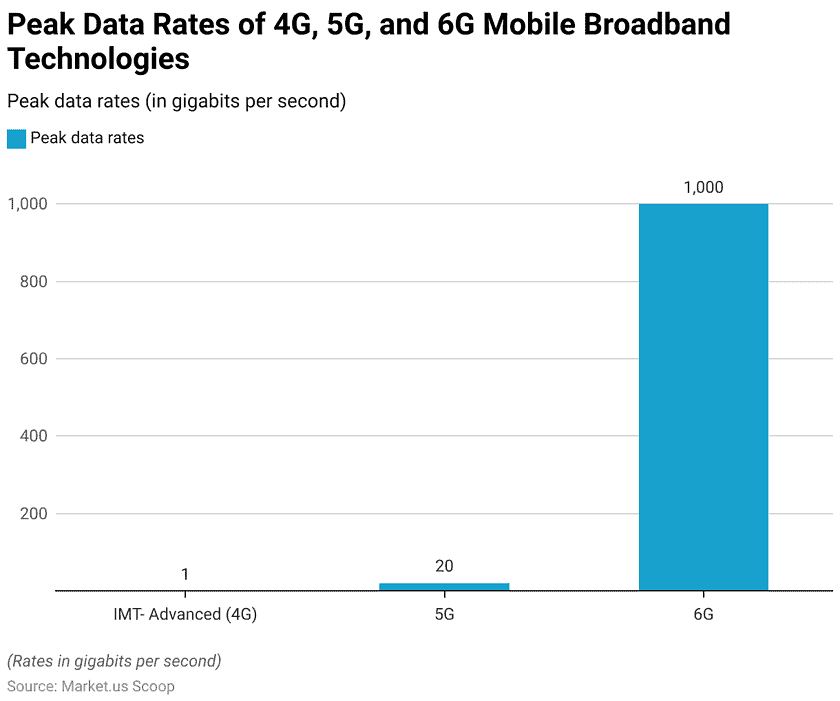
User Experience Data Rates
- In the realm of mobile broadband technologies, user experience data rates have witnessed remarkable evolution.
- The previous generation, IMT-Advanced or 4G, provided user experience data rates of 10 megabits per second (Mbps), representing a notable improvement over its predecessors.
- With the introduction of 5G, user experience data rates escalated to 100 Mbps, signifying a significant enhancement in mobile broadband performance.
- Looking ahead to the anticipated 6G technology, it is projected to deliver extraordinary user experience data rates of 1000 Mbps (1 gigabit per second or Gbps). Marking an exponential leap that promises to redefine the way users interact with digital content and services.
- This impressive progression underscores the relentless pursuit of faster and more immersive wireless connectivity in the modern era.
(Source: Statista)

6G Network Use Cases Statistics
- In the ongoing discussions about 6G, a central theme revolves around the advancement of machine-to-machine (M2M) communications.
- One notable aspect is the freedom from constraints imposed by data rates. Allowing millions of devices in a relatively small area to collaborate on intricate tasks requiring substantial computational power without overwhelming the network.
- This paves the way for networks where multiple devices, equipped with artificial intelligence and machine learning capabilities, can collaborate seamlessly on complex assignments.
- Additionally, organizations like Samsung, Nokia, and the International Telecommunications Union (ITU) have outlined other potential use cases in recent whitepapers.
- These include truly immersive experiences through XR high-fidelity (a blend of virtual reality, augmented reality, and mixed reality), high-quality holograms, and digital replicas.
- These applications hold tremendous promise across various domains. Including healthcare with the potential for remote surgery, education, vocational training, and telecommunications.
(Source: Statista)
6G Transport Network Investment Projections Statistics
- The global investment in 6G transport networks is projected to experience substantial growth in the coming years.
- In 2025, the investment is estimated at 28 million U.S. dollars. Signaling the initial steps in the development of this advanced network.
- The following year, in 2026, the investment is expected to rise to 45 million U.S. dollars. Reflecting a growing commitment to 6G technology.
- As we progress to 2027, the investment is anticipated to further increase to 77 million U.S. dollars, demonstrating the escalating momentum behind 6G.
- In 2028, a significant leap is forecasted, with investment reaching 134 million U.S. dollars, underscoring the recognition of 6G’s potential.
- Looking ahead to 2029, the investment is set to nearly double. Reaching 249 million U.S. dollars, and by 2030, it is projected to reach a substantial 505 million U.S. dollars. Reflecting the substantial financial support and dedication to the development of 6G transport networks on a global scale.
(Source: Mind Commerce)
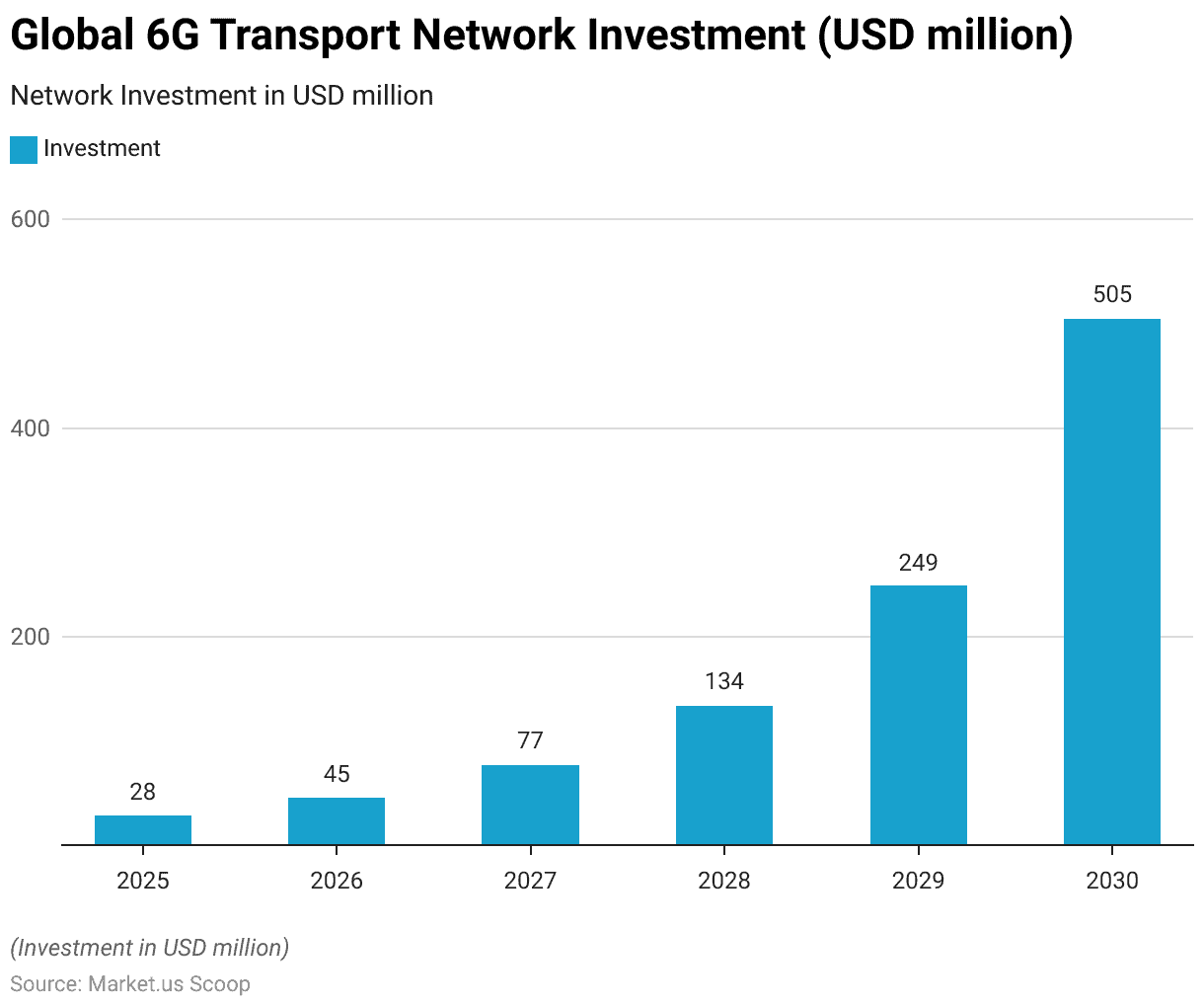
Privacy Challenges in 6G Technology Statistics
- Privacy is a significant concern in 6G innovation, given the potential for global connectivity to expose an individual’s entire life through a single data breach.
- However, 6G offers enhanced privacy through quantum computing-based safeguards. The role of 6G in society may depend on addressing these security concerns.
- FTC mandates “reasonable security” measures and various bodies oversee privacy. The SEC guides cybersecurity in finance, the DHS investigates cybercrime, and the Department of Commerce enhances awareness.
- New York State has enacted regulations, such as the SHIELD Act, requiring “reasonable” security measures, including training and adapting protocols. The Act empowers fines for non-compliance.
- The California Consumer Privacy Act was implemented in 2018. Imposes fines of $750 per breach per consumer per occurrence or actual damages.
- Moreover, proving harm from data breaches in private lawsuits has been challenging in certain cases. However, this could change as 6G networks are expected to amplify our dependence on data.
(Source: JDSupra, epic.org)
Recent Developments
Acquisitions and Mergers:
- Nokia acquires 6G research startup Biconic: In 2024, Nokia acquired Biconic, a startup specializing in 6G network technologies, for $80 million. This acquisition will enhance Nokia’s capabilities in advanced 6G research and development, particularly in terahertz (THz) communication technologies.
- Ericsson merges with EdgeTech: In early 2024, Ericsson merged with EdgeTech, a company focused on edge computing solutions for future network technologies, in a deal worth $500 million. This merger is aimed at integrating edge computing and AI into Ericsson’s 6G solutions. Boosting performance for smart cities and autonomous systems.
New Product Launches:
- Samsung unveils 6G-ready chipsets: In mid-2023, Samsung introduced its 6G-ready chipsets, designed to support ultra-high-speed data transfer and low-latency communication for future 6G networks. These chipsets offer a 10x increase in data throughput compared to existing 5G technologies.
- Huawei launches 6G satellite connectivity prototype: In early 2024, Huawei launched its 6G satellite prototype, designed to enable seamless global connectivity. The system integrates satellite and terrestrial 6G networks, providing coverage even in remote areas.
Funding:
- U.S. government allocates $500 million for 6G R&D: In 2023, the U.S. government announced a $500 million funding initiative to accelerate 6G research and development. Focusing on advanced communication technologies such as terahertz frequencies, AI integration, and quantum computing for next-gen networks.
- EU invests $900 million in 6G research: In 2024, the European Union allocated $900 million for 6G research and development as part of its Horizon Europe program. The funding will be used to develop infrastructure, applications, and use cases for 6G in smart cities, healthcare, and autonomous systems.
Technological Advancements:
- Terahertz (THz) communication for 6G: Terahertz frequencies are emerging as a key component of 6G networks. By 2025, 30% of 6G research will focus on THz communication. Enabling data transfer rates up to 100 Gbps, far exceeding current 5G speeds.
- AI and machine learning in 6G networks: AI-driven networks are a major trend in 6G development. By 2026, 40% of 6G networks are expected to integrate AI and machine learning for autonomous management. Optimizing resource allocation, and improving network performance.
Conclusion
6G Statistics – 6G technology marks a significant advancement in wireless communication, offering remarkable data speeds, minimal delays, and transformative possibilities.
It has the potential to revolutionize various industries by enabling cutting-edge applications like augmented reality, virtual reality, and the Internet of Things, thereby elevating our digital interactions.
As we look forward to its development and deployment, it’s vital to address the accompanying challenges, particularly in terms of privacy and security.
Ensuring that the progress in 6G is accompanied by robust protective measures is essential to fully realize its potential for the betterment of society.
FAQs
6G refers to the sixth generation of wireless technology, succeeding 5G. It is envisioned to provide significantly faster data speeds, lower latency, and advanced capabilities for wireless communication.
6G is expected to offer features such as terahertz frequencies, extremely high data rates, near-instantaneous communication, and support for massive IoT (Internet of Things) devices.
6G could revolutionize various industries, including healthcare, and autonomous vehicles. Augmented reality, and smart cities, enable faster and more reliable wireless connections.
Commercial deployment of 6G is anticipated around 2030, with research and development efforts currently underway to define its standards and capabilities.
While not directly related, 6G’s high-speed, low-latency capabilities can support data-intensive applications related to sustainability. Such as remote monitoring of renewable energy sources or efficient supply chain management for natural products.
Discuss your needs with our analyst
Please share your requirements with more details so our analyst can check if they can solve your problem(s)



